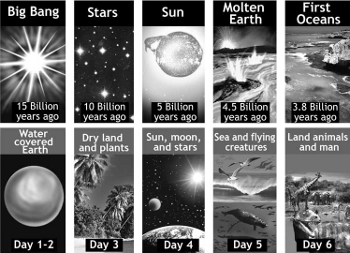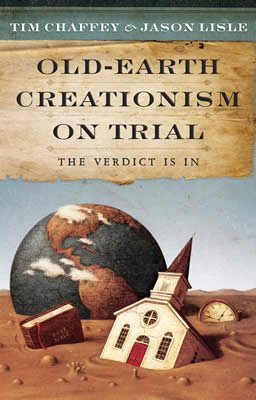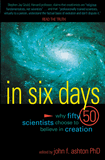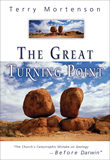
Problems with Other “Interpretations”
Appendix B
Old-earth interpretations each have several problems. These selected examples should be more than enough to make the point.
| Problem/Theory | Gap Theory | Theistic Evolution | Day-Age Theory | Progressive Creation | Framework Hypothesis |
|---|---|---|---|---|---|
| Places death before sin | X | X | X | X | X |
| Sun created before earth | X | X | X | X | X |
| Satan fell before end of creation week | X | X | X | X | X |
| Dinosaurs did not live with man | X | X | X | X | X |
| Noah's flood was not a worldwide catastrophe | X | X | X | X | X |
| All creation was not “very good” | X | X | X | X | X |
| Symbiotic relationships non-existent | X | X | X | X | |
| Other “order of events” conflict | X | X | X | X | X |
There are certainly many more problems that each of these views create. These consist of biblical and scientific problems. These selected examples should be more than enough to make the point.
Death before Sin
This is perhaps the biggest problem created by each of the compromising views. The Bible makes it very clear that there was absolutely no death before Adam sinned. Romans 5:12 states, “Therefore, just as through one man sin entered the world, and death through sin… .
” First Corinthians 15:21 states, “For since by man [Adam] came death, by Man [Jesus] also came the resurrection of the dead.
” These passages are dealing primarily with human death, but it is also clear from Romans 8 that sin affected all of creation. Scripture is clear that animal death was instituted when Adam sinned, as we will show below.
Each of the old-earth views places death, bloodshed, disease, and suffering before Adam’s sin.
Each of the old-earth views places death, bloodshed, disease, and suffering before Adam’s sin. However, the Bible teaches that all was “very good” (Gen. 1:31) when God made it. Would God have called everything that He had made “very good” if it were full of death and suffering? Absolutely not! Remember, Jesus healed the sick and resurrected the dead. Why would He do these things if these people were already in a “very good” state? Death and suffering were not a part of the original creation but only entered because of the fall of man. Further evidence for this is provided by the fact that people and animals were originally allowed to eat plants only (Gen. 1:29–30).
Besides the fact that it contradicts the Bible, the reason that this problem is so severe is because it undermines the very meaning of the atonement. When Adam sinned, the Bible states that God made coats of skins for Adam and Eve. Here is the first indication of death in the Bible. God killed an animal (quite possibly a lamb or lambs—although the Bible does not say directly) to make these coats. This would have served as a graphic portrayal of the consequences of Adam’s sin. Adam would have seen blood being shed for the first time in atonement for sin. What a powerful picture of the devastating effects of sin and of the coming Messiah. However, if the world were already full of death and bloodshed (as old-earthers teach) then this action would be meaningless. Adam would certainly not infer that the wages of sin is death. If death and suffering were already in the world, then sin did virtually nothing. If the foundations for the gospel are undermined, then why did Jesus Christ come to earth to die on the cross for our sins? He was the ultimate sacrifice, the Lamb of God who takes away the sins of the world. But if there was death before sin, what did sin do? If it was part of the original creation, then why did Jesus need to shed His blood?
The old-earth views still have many additional problems in this area. As a result of Adam’s sin, God cursed the ground (Gen. 3:17–18) to bring forth thorns and thistles. Yet we find thorns and thistles in the fossil record that are allegedly millions of years old, according to old-earthers. Why would God curse the ground with thorns if they were already in abundance on the earth? It just does not make sense and it does not line up with God’s Word.
The Sun Created before the Earth
Because each of the old-earth views accepts the evolutionary time scale of “billions of years” for the age of the earth and universe, they run into another glaring problem. Secular origin models of the solar system (which each of these theories embrace) state that the sun was formed before the earth. However, according to the Bible, the earth was made on day 1 while the sun was created on day 4.
In an attempt to circumvent this problem, Dr. Ross claims that the Bible teaches that the sun “appeared” or became visible on the earth on day 4. He believes that the sun existed long before the earth. However, the Hebrew language does not allow for this. The Hebrew word used in the creation of the sun (the “greater light”) is asah, which means “to make.” It is very different than the Hebrew word ra’ah, which is translated “appear” (as the land does in Genesis 1:9). So, this is another example of twisting Scripture to fit preconceived notions. It is absolutely essential to allow the Bible to speak for itself rather than trying to fit one’s ideas into the Bible. God does not need the help of modern secular scientific opinion.
The people that hold to these compromise views will often ask where the light came from on the first three days. The simple answer is that the Bible does not tell us, but it does state that there was light. The sun is not necessary for day and night—only a directional light source is needed. The Bible is clear that light was in existence since the first day: And God said, “Let there be light.” Revelation 21:22–22:5 may provide the answer to this question. It states that in the New Jerusalem there will be no need of the sun because God’s glory will illuminate it. This is a possibility as to where the light came from for the days in question. Another possibility is that God may have used a temporary light source. However, since the Bible does not tell us, we should be cautious and not dogmatic with our speculations.
Satan Fell before the End of the Creation Week
Once again, the compromise views create a theological dilemma. The gap theory (the ruin-and-reconstruction version) teaches that Satan fell and led earth in a rebellion against God prior to Genesis 1:2. The other theories teach death and suffering prior to the fall of man. They also claim that Satan rebelled prior to the end of the creation week. This concept is problematic for the following reasons.
a) God stated that everything He had created was “very good” at the end of the sixth day. We know that Satan was created at some point during the creation week, because Exodus 20:11 states that God made everything in the earth, the sea, and the heavens in six days. Satan is included in this. Job 38:7 teaches that the angels rejoiced when God laid the foundations of the earth. This indicates that the angels were made early on in the creation week. They would not have fallen before the sixth day because everything God made was still “very good.”
b) Ezekiel 28:12–19 suggests that Satan was in Eden and was perfect “till iniquity was found in” him. How could Satan have been in the Garden of Eden and be perfect if he fell long before the Garden was ever created?
Man Did Not Live with Dinosaurs
It is commonly taught that dinosaurs and man did not live together. Evolutionists claim that dinosaurs died out some 65 million years ago. Each of these compromising views also teaches this. However, it can easily be demonstrated that this is not the case.
The Bible teaches that land animals (everything that creeps upon the earth) were made on the sixth day of creation—the same day human beings were created. Dinosaurs were land animals. Therefore, human beings and dinosaurs most certainly lived at the same time, since they were created on the same day. This is a logical deduction, even if the Bible didn’t mention dinosaurs specifically. However, the Bible does indeed describe animals that resemble dinosaurs and other extinct reptiles such as plesiosaurs or flying reptiles. (The latter are not classified as dinosaurs, but are equally devastating to old-earth views.) In the Book of Job, God tells Job about the behemoth and the leviathan. Many study Bibles will include a text note that these were probably the elephant or hippopotamus and the crocodile. It is important to remember that the text of Scripture is inspired, but the text notes are not. These editors were obviously influenced by the evolutionary idea that dinosaurs died out long before man arrived on the screen.
A brief examination of this passage will demonstrate that the text notes in these Bibles are wrong. The description of this creature in Job 40 perfectly fits that of a sauropod dinosaur such as Brachiosaurus. Would the elephant’s tail or hippo’s tail remind anyone of a “cedar tree” (v. 17)? While it may be true that the word translated as “tail” could possibly be rendered “trunk,” there is another problem. If the word should be “trunk,” then why does Job 40:24 state that this creature has a nose? This statement rules out the possibility of behemoth being an elephant. The leviathan is described as being capable of breathing fire and raising itself up. When was the last time you saw a crocodile breathe fire or rise up?
In January of 2004, Dr. Mary Schweitzer discovered soft tissue from a Tyrannosaurus Rex leg bone. Although she believes the fossil is millions of years old, evolutionists are at a loss as to how the soft tissue could have been preserved for so long.1 This is perfectly consistent with the biblical teaching that dinosaurs were created on the same day as man.
Literally hundreds of cultures from around the world have dragon legends. The description of these creatures often matches that of dinosaurs. Dinosaur pictographs have been found all over the world. How could ancient people have known about these creatures, since they did not have the fossil remains? Also, numerous historical records exist that tell of men fighting against dragons. Are all of these simply fairy tales or is it possible that some of them are historical events? The fact that these occur in numerous cultures around the globe is a strong argument in favor of men and dinosaurs existing together.

Also, the very idea that God created billions upon billions of animals for millions of years before man ever came on the scene strikes against the very purpose of the creation. In Genesis 1:28, God gave man dominion over all of the earth and its creatures. What possible reason would God have in making creatures such as dinosaurs, and then allowing them to suffer and die millions of years before man ever had a chance to enjoy and appreciate these marvelous creatures? The answer, of course, is that He did not do it this way. God created all the original kinds of animals and Adam and Eve within a two-day time period—days 5 and 6 of the creation week.
Noah’s Flood Was Not a Worldwide Catastrophe
In terms of geology, either the bulk of the fossils were deposited in a global flood or they were deposited over millions of years. It would be geologically absurd to suppose that there was a worldwide flood that deposited no new fossils, nor disturbed any previous ones. Therefore, old-earth creationists must deny a worldwide flood. But, the Bible makes it clear that Noah’s flood was global—the waters covered all the high hills under the whole heaven (Gen. 7:19). This was examined in detail in chapters 5 and 6.
All of Creation Was Not “Very Good”
The Bible makes it abundantly clear that everything was “very good” at the end of the creation week. Six times throughout Genesis 1 we are told that God saw that what He had made was good (verses 4, 10, 12, 18, 21, 25). In verse 31, we are told that everything was “very good.”
The problem is that if any of these other views is correct then God said that death, disease, bloodshed, suffering, and pain were all “good” and “very good.” This is not consistent with the nature of the God of the Bible. The Bible tells us that death is the last enemy that will be destroyed (1 Cor. 15:26). As such, it could not have been a part of God’s original creation. If God called these things “very good,” then one must wonder if God truly is loving.
Symbiotic Relationships Non-Existent
There are countless relationships that exist between certain types of creatures in which one could not survive without the other. For example, certain plants need certain insects for pollination purposes. These same insects rely on the plant for their source of food.
If any of the above theories were correct, then plants were created millions of years before the insects. There are so many other symbiotic relationships that exist between one type of plant and one type of animal or between two types of animals. It is preposterous to believe that they survived without each other for millions of years.
Other “Order of Events” Conflict
Inserting vast ages into the Bible’s first chapter sets it at odds with modern secular scientific opinion regarding the order of events. Old-earth theory places reptiles before birds (some would claim that birds evolved from reptiles), while the Bible claims it was the other way around. Old-earthers believe that fish and sea creatures came before the land vegetation, but again, the Bible has it the other way. Old-earthers put land mammals before whales. Again, this is completely opposite of what the Bible claims. Dozens of other examples could be cited, but these are listed to show that it is impossible to add long periods of time into the biblical account without seriously damaging the doctrine of inerrancy.2
Conclusion
Whenever ideas foreign to Scripture are imported into it, difficulties and contradictions ensue. The Bible is self-authenticating. It does not need the help of fallible men to make it accurate. God says what He means and means what He says.
Old-Earth Creationism on Trial
Opting to skirt the controversy of Genesis as literal history, the biblical authority of the Holy Word is called into question and reduced to a collection of mere stories.
Read Online Buy BookFootnotes
- See Discover magazine’s article at http://discovermagazine.com/2006/apr/dinosaur-dna. Accessed July 18, 2007.
- For a more complete list of the differences in the order of events, see Dr. Terry Mortenson’s article at: https://answersingenesis.org/why-does-creation-matter/evolution-vs-creation-the-order-of-events-matters/. Accessed July 18, 2007.
Recommended Resources

Answers in Genesis is an apologetics ministry, dedicated to helping Christians defend their faith and proclaim the good news of Jesus Christ.
- Customer Service 800.778.3390
- © 2025 Answers in Genesis







